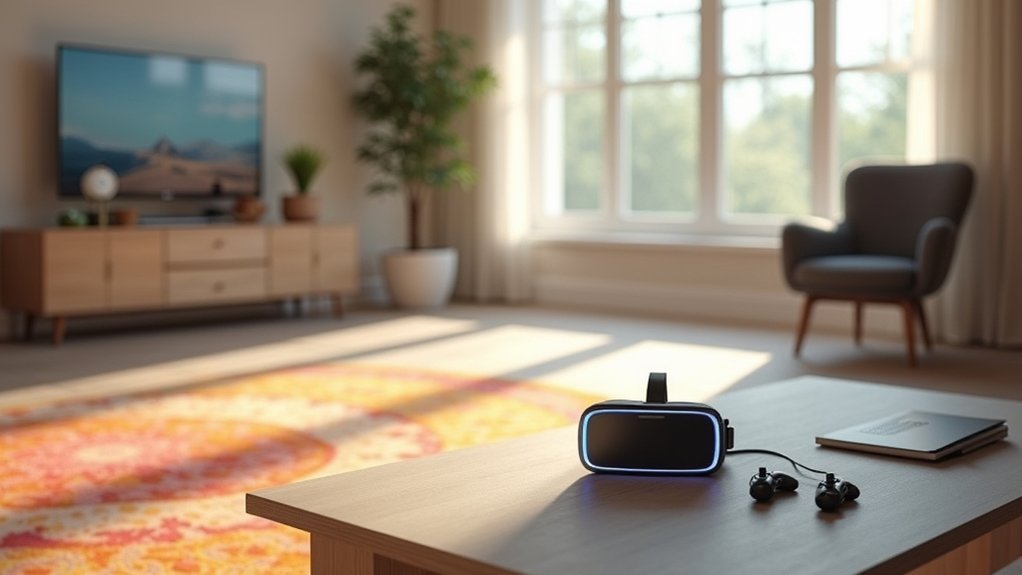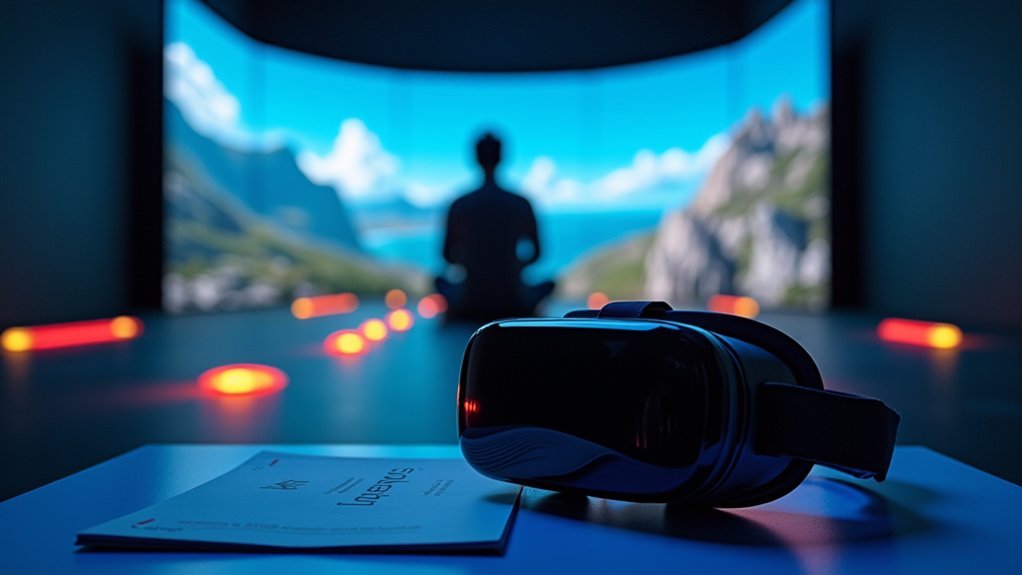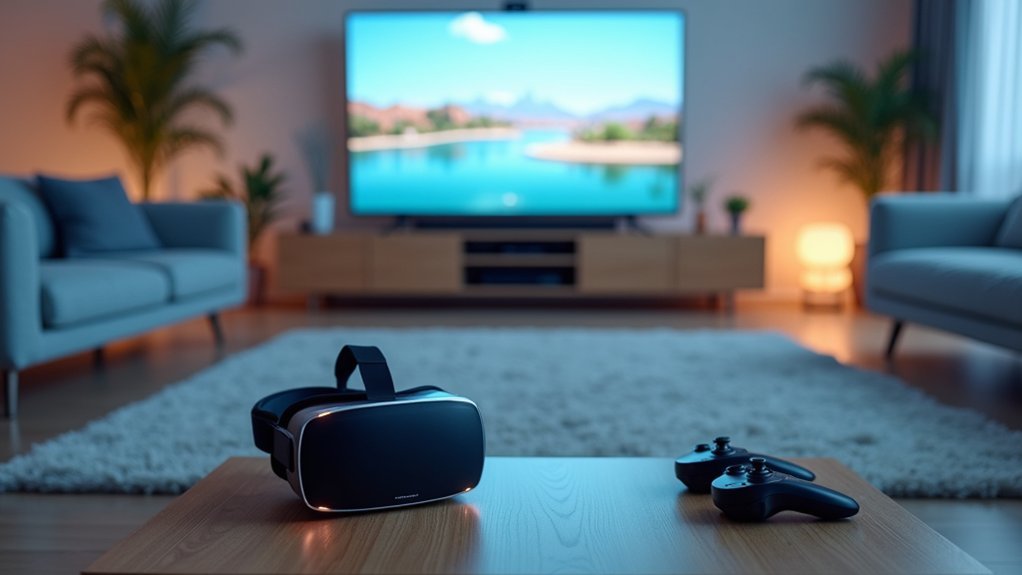You’ll want to clear your play area of all obstacles and sharp-cornered furniture first, then establish physical boundaries with at least one-third meter buffer zones from walls. Limit your VR sessions to 20-30 minutes with regular breaks to prevent disorientation and motion sickness. Always use a spotter to monitor your movements and alert you to potential hazards during intense experiences. Finally, trust your instincts and don’t rely solely on built-in safety systems—they can fail. These foundational steps open up safer virtual adventures ahead.
Clear Your Play Area of All Obstacles and Hazards

Before you slip on your VR headset and immerse yourself in virtual worlds, you’ll need to transform your physical space into a safe haven.
When you clear your play area, start by removing furniture with sharp corners like tables and chairs that could cause injury during gameplay. Secure or eliminate tripping hazards including cables, plants, and metal objects scattered around your space.
Glass tables and delicate items must be relocated since they’ll shatter if bumped accidentally. Keep your floor completely unobstructed and guarantee no suspended objects hang above.
These essential safety tips include touching all four walls before starting to familiarize yourself with boundaries. Removing obstacles and hazards creates the secure environment necessary for worry-free VR experiences.
Establish Physical Boundaries and Buffer Zones
Once you’ve cleared all obstacles from your VR space, you’ll need to establish firm physical boundaries that keep you safely within your designated play area.
Start by touching all four walls of your available space before each VR session. This simple practice reinforces spatial awareness and prevents dangerous collisions during gameplay.
Create a buffer zone of at least one-third meter between your virtual boundaries and physical walls. These physical constraints provide essential safety margins when you’re immersed in virtual worlds and moving naturally.
Install durable flooring like rubber or LVT within your play area. This tactile feedback helps you stay oriented and reduces motion sickness.
Always check for new obstacles before playing, and verify overhead space remains clear of suspended objects that could cause accidents.
Limit Session Duration and Take Regular Breaks

While setting up proper boundaries protects you physically, managing your time in VR safeguards your body from the unique strain that virtual environments create.
You’ll need to limit session duration to 20-30 minutes maximum to prevent disorientation and discomfort. The immersive nature of VR can make you forget you’re wearing a headset, so set reminders to take regular breaks.
Essential VR timing safety warnings include:
- Take 3-minute breaks between sessions to let your eyes recuperate and stay hydrated
- Set timer reminders since immersion makes you lose track of time wearing the headset
- Watch for coordination issues as extended use impairs hand-eye coordination and multitasking abilities
Regular breaks prevent motion sickness and guarantee you’ll enjoy VR safely without compromising your physical well-being.
Use a Spotter During VR Sessions
Having a dedicated spotter transforms VR gaming from a solo risk into a team safety approach.
You’ll want someone monitoring your movements while you’re immersed in virtual worlds, as they can prevent accidents caused by sudden disorientation or instinctive reactions.
Your spotter acts as your real-world guardian, alerting you to potential hazards and guiding you away from walls, furniture, or other obstacles.
They’re especially valuable during intense VR experiences where adrenaline might trigger unexpected movements that could cause injury.
Beyond safety, spotters enhance your play area management by keeping the space clear of dangers while you’re engaged.
They’ll also boost your overall enjoyment through shared interaction and support, making VR experiences safer and more social.
Heed Safety Warnings and Trust Your Instincts

Although VR systems offer built-in safety alerts to warn you of approaching boundaries, you shouldn’t rely entirely on these automated warnings.
Hardware or software failures can disable these safety alarm features when you need them most. Over-reliance on system alerts creates dangerous blind spots in your spatial awareness.
Don’t let technology become a crutch—system malfunctions can leave you vulnerable when safety alerts fail unexpectedly.
Trusting your instincts remains your most reliable safety tool. If something feels off or you sense you’re approaching an obstacle, pause immediately and assess your surroundings. Your natural awareness often detects hazards faster than automated systems.
- Always listen to your gut feelings about spatial positioning during gameplay
- Have a spotter monitor your movements and provide verbal warnings when needed
- Regularly scan your play area for new obstacles before each session
Frequently Asked Questions
What Are the Safety Precautions for VR?
You should limit sessions to 20-30 minutes, clear your play area of hazards, use a spotter when possible, heed system alerts, and keep pets away to prevent accidents.
Is There a Way to Prevent VR Motion Sickness?
You can prevent VR motion sickness by limiting sessions to 20-30 minutes, taking regular breaks, starting with gentle experiences, adjusting headset focus settings, and staying seated initially.
How to Room-Scale VR?
You’ll need at least five meters diagonally with proper sensor placement. Mount two sensors eight feet high, clear obstacles from your space, establish boundaries, and walk the perimeter to familiarize yourself with the area.
Is VR Safe for the Brain?
VR’s generally safe for your brain when you use it moderately. You’ll benefit from enhanced cognitive function and spatial awareness, but you should limit sessions to 20-30 minutes to avoid disorientation and eye strain.
In Summary
You’ve got the essential knowledge to enjoy room-scale VR safely. Don’t skip clearing your space or setting boundaries—they’re your first line of defense against injury. Remember to take breaks, use a spotter when possible, and always listen to your body’s warning signals. If something doesn’t feel right, stop immediately. Follow these five safety tips consistently, and you’ll create countless immersive experiences without compromising your well-being or damaging your surroundings.





Leave a Reply